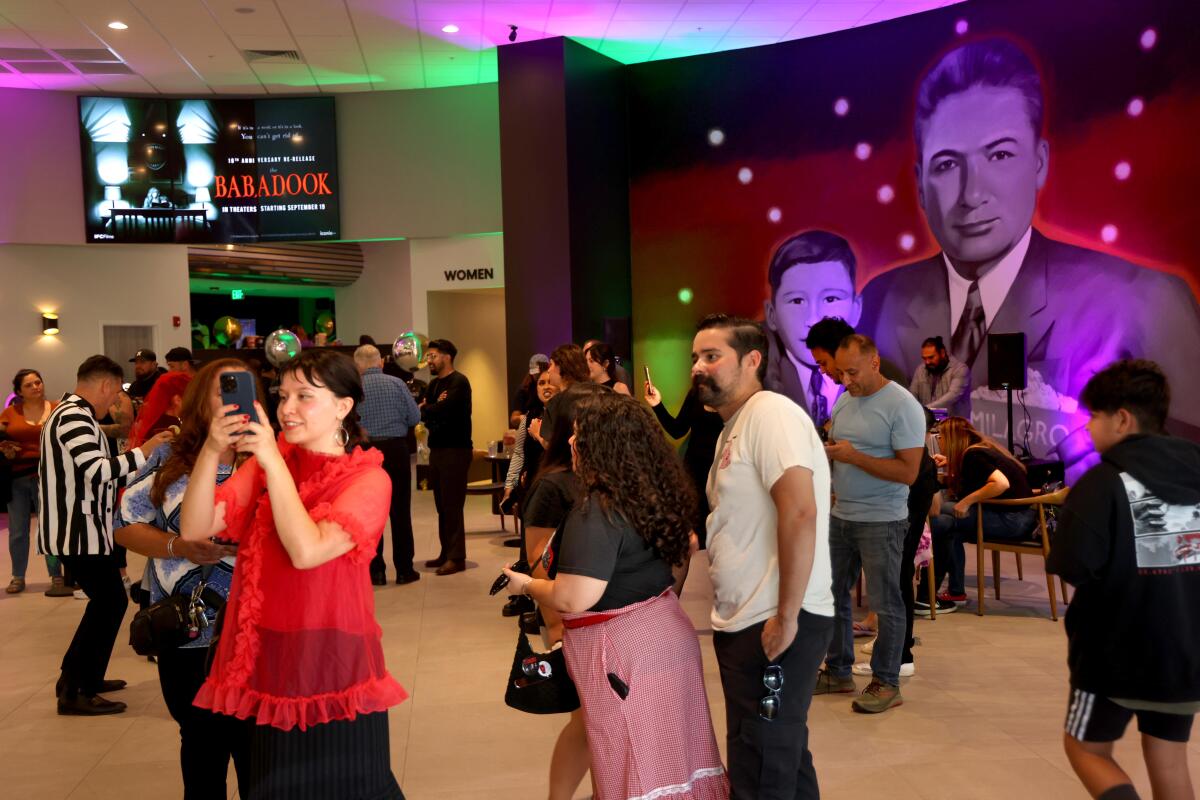In Norwalk, a hot new movie theater bucks industry trends: ‘It’s speaking my language’

- Share via
The audience inside the largest auditorium at Norwalk’s new Milagro Cinemas was jazzed. Although other theaters in the multiplex played “Beetlejuice Beetlejuice,” “Transformers One” and other hits, this crowd was celebrating one of last year’s most notable disappointments.
The object of their affection was DC Comics’ “Blue Beetle,” about young Jaime Reyes (Xolo Maridueña), who acquires a bug-like armored suit with superpowers, including the ability to fly. Despite positive reviews and a promising opening weekend in August 2023 — one that knocked blockbuster “Barbie” out of the top box office slot — “Blue Beetle” quickly faded, eventually becoming the lowest-grossing film in the DC Extended Universe.
But “Blue Beetle’s” return engagement last month, a little more than a year after first hitting theaters, was a triumph for Milagro Cinemas and its founder, veteran producer Moctesuma Esparza, 75. A predominantly Latino audience, including children in Blue Beetle costumes, came to cheer the first Latino comic book character to headline his own live-action superhero saga. And the applause grew even louder after the film, when Maridueña and co-star Belissa Escobedo bounded to the front of the theater. As the stars bantered about the film, hundreds of other fans swarmed the main lobby waiting to get into the second sold-out screening.
The event marked a defining moment for the newly opened theater: While the COVID-19 pandemic, economic headwinds and changes in the theatrical film model have led to the closure of several popular L.A.-area cinemas, such as Hollywood’s Arclight Cinerama Dome, Westwood’s Regency Village and Fox Bruin theaters and Landmark’s Westside Pavillion location, Esparza is moving in the opposite direction, taking a multimillion-dollar gamble with the opening of Milagro at the Norwalk Town Square shopping mall.

He is realizing his mission to bring a state-of-the-art cinema to the largely Latino community, who he says has lacked one for years. He also wants the theater to serve as a cultural bridge between Hollywood and local Latino creative circles, sending a reminder to the studios that Latino audiences are among the most fervent supporters of theatrical film fare.
Renovating an aging theater that had been shut down for years, Milagro Cinemas is a “theater that will be luxurious by any standard, that could fit in Beverly Hills or down the street from the Academy of Motion Picture Arts and Sciences,” Esparza said in a recent interview with The Times. The theater includes a D-Box auditorium, laser projection, stadium seating, luxury recliners, swivel tables and immersive Dolby Atmos speakers.
The theater has already hosted several special events to heighten the ordinary filmgoing experience. An opening weekend party for “Beetlejuice Beetlejuice” attracted fans of the original film as well as kids, while a celebration for the opening of “Joker: Folie à Deux” featured KCRW DJ José Galván.
In addition to major films, at least one of Milagro’s screens will be dedicated to Latino filmmakers and culture, as well as independent films. The spacious snack bar offers traditional movie theater treats as well as street tacos, burritos and chorizo supreme pizza. Margaritas, sangria and other libations are also available at the bar.
With a $56-million opening, ‘Bad Boys: Ride or Die’ offers Hollywood a glimmer of hope amid box office woes — and a reminder that it neglects audiences of color at its peril.
Esparza is counting on Latinos’ proven moviegoing appetite, which he says has been ignored by the entertainment industry. Nearly a million residents live within a 10-minute drive of Norwalk, and 70% of them are Latino.
“Latinos go to the movies more than anyone else,” said Esparza, whose producing credits include “Selena,” starring Jennifer Lopez; “Introducing Dorothy Dandridge,” starring Halle Berry; “The Milagro Beanfield War,” “Gettysburg” and “Gods and Generals.” “They account for 25% of the national box office by themselves. And we are the most underrepresented population in Hollywood by far. When you consider Mexican Americans and Chicanos, we’re even worse off.”
That strong turnout has been demonstrated several times this year. When “Bad Boys: Ride or Die,” starring Will Smith and Martin Lawrence, premiered this summer, 26% of the audience was Latino and Hispanic. The $56-million opening weekend outdistanced other heavily hyped fare such as “The Fall Guy” and “Furiosa: A Mad Max Saga.”
The blockbuster success of “Beetlejuice Beetlejuice” has also been driven by Latino audiences, who were responsible for 36% of the opening night crowd, according to box office analysts.

Despite that support, Esparza is troubled by the lack of diversity among industry power brokers, which, in turn, shapes the lack of outreach to that very audience: “There’s something wrong with Hollywood,” he said, noting that it’s “astonishing” to see so few Latino executives and actors in an industry based in a city whose population is nearly half Latino.
“Why is this going on?” he said. “Why do I have a career that has been going on for 50 years, and in that time, I have never had the honor or privilege of pitching a Mexican American who has any kind of influence or power at a studio or network?”
His concerns echo the sentiments voiced by John Leguizamo, who called out Hollywood during last month’s Emmy Awards. Although the actor acknowledged progress has been made, the industry “needs more stories from excluded groups,” he said.
Establishing Milagro Cinemas not only as an attractive destination for filmgoers but also as a cultural hub is essential to Esparza’s vision.
According to the recent report from the Annenberg Inclusion Initiative at USC, Latino representation in Hollywood has not shown any meaningful growth in the last 16 years.
“We have been missing a community of Latinos, so here we’re hoping to be part of the solution, to create that community and social hub, where filmmakers, actors and executives can feel they have a space where they can celebrate, talk about projects, what they have been doing, have done and hope to do,” Esparza said.
He continued: “We want to be that reach from Norwalk to Hollywood, where studios and streamers that are doing the programming get a better sense of all the talent that exists — the ability and talent to tell stories that relate to their lives in a way that Hollywood has done for so many other communities, Italian, Irish, Jewish, African American, Asian [American] and Native American. That has been missing for Latinos.”
In addition to Milagro and his producing projects, Esparza has also developed Maya Cinemas, a chain of luxury theaters situated in other underserved areas such as Bakersfield, Fresno and Salinas.
His mission is personal. His fondest memories from his life as a young boy are of going to the movies in downtown Los Angeles every Monday with his father.
“We’d go to the Million Dollar Theater where they would have Mexican vaudeville. Then we’d go down the street to the State Theater or the Orpheum to see Hollywood movies,” he recalled. A huge mural of a young Esparza and his father by Robert Vargas now highlights the Milagro Cinemas lobby.
So far, the venture appears to have struck a chord with the community.
“It’s beautiful, and I just love the upgrade,” said Alonzo Mendoza, 42,who lives a few minutes from the multiplex. “Just having it named Milagro says a lot — it’s speaking my language. It’s giving back to the neighborhood.”
Added Ramon Galvez, 43, of Pico Rivera: “I used to come here, and it was not comfortable. I didn’t even want to think about some of the stuff that was sticking on the floor. Now it’s a safe and clean environment. And it’s great to have a place to see Hispanic movies.”
Both Mendoza and Galvez had come to see “Blue Beetle” even though they had seen it before. To see it on a big screen with an audience was a special occasion, they said. And, because last year’s SAG-AFTRA strike prevented the stars of the film from doing the promotional rounds, the Milagro Cinemas event had a premiere atmosphere, allowing the actors in attendance to connect in person with adoring fans.
“It felt like the kind of celebratory energy that you have at cast parties,” Esparza said. “They stayed for hours, just celebrating that we were all together.”
More to Read
Only good movies
Get the Indie Focus newsletter, Mark Olsen's weekly guide to the world of cinema.
You may occasionally receive promotional content from the Los Angeles Times.













